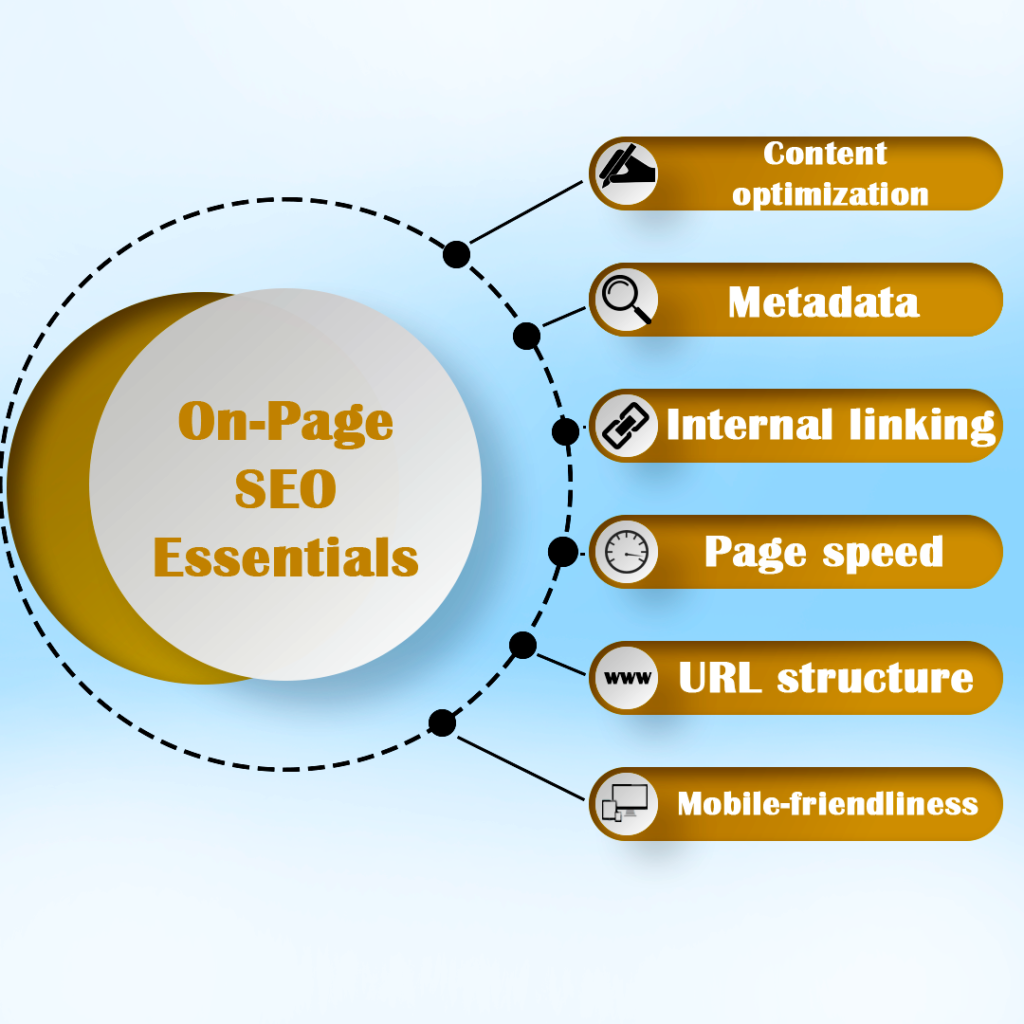On-Page SEO Essentials: The Complete Checklist for 2025

Search engine optimization (SEO) evolves constantly, but on-page SEO remains a cornerstone of successful digital marketing strategies. Whether you’re optimizing a new site or improving an existing one, focusing on on-page SEO essentials can significantly enhance your rankings and drive organic traffic. This guide provides a comprehensive checklist tailored for 2025 to help you stay ahead of the competition.
Table of Contents
Introduction to On-Page SEO
On-page SEO involves optimizing the elements within your website to improve its visibility in search engines. Unlike off-page SEO, which focuses on backlinks and external signals, on-page SEO gives you direct control over your content and technical aspects.
Key areas include:
- Content optimization
- Metadata
- URL structure
- Internal linking
- Mobile-friendliness
- Page speed
This complete checklist will guide you through the must-do practices for 2025.

1. Conduct Thorough Keyword Research
Before you start optimizing, you need to know what your audience is searching for. Here’s how to get started:
- Use Updated Tools: Tools like Google Keyword Planner, Ahrefs, and Semrush provide insights into search volumes, trends, and competition.
- Target Long-Tail Keywords: Long-tail keywords often have less competition and higher intent.
- Analyze Search Intent: Determine whether users are looking for information (informational), products (transactional), or a mix of both.
Pro Tip: Prioritize keywords that align with your goals, whether it’s driving sales, generating leads, or increasing brand awareness.
2. Optimize Title Tags
Your title tag is the first thing search engines and users see. It’s a powerful factor for both rankings and click-through rates (CTR).
- Include Primary Keywords: Ensure your target keyword is naturally placed at the beginning of the title.
- Keep It Concise: Stick to 50-60 characters to prevent truncation in search results.
- Use Power Words: Words like “ultimate,” “essential,” or “guide” can increase clicks.
Example:
Instead of “SEO Checklist for 2025”, try “The Ultimate On-Page SEO Checklist for 2025.”
3. Craft Engaging Meta Descriptions
While not a direct ranking factor, meta descriptions influence CTR, which indirectly impacts rankings.
- Summarize the Content: Provide a compelling overview of your page.
- Incorporate Keywords: Use primary and secondary keywords naturally.
- Stay Within Limits: Aim for 150-160 characters.
4. Structure URLs Properly
SEO-friendly URLs improve rankings and user experience.
- Keep Them Short and Descriptive: Avoid long, confusing strings of numbers or characters.
- Include Keywords: Use your target keyword in the URL.
- Use Hyphens: Separate words with hyphens for better readability.
Example:
Instead of example.com/page12345, use example.com/on-page-seo-checklist.
5. Create High-Quality, Relevant Content
Content remains the king of SEO, but 2025 emphasizes quality over quantity.
- Answer User Questions: Address pain points and provide solutions.
- Incorporate Keywords Naturally: Avoid keyword stuffing.
- Use Headings and Subheadings: Break content into sections with H1, H2, and H3 tags.
- Add Multimedia: Enhance engagement with images, videos, and infographics.
6. Implement Proper Header Tags
Headers improve both readability and SEO.
- Use One H1 Tag Per Page: It should include the primary keyword and reflect the page’s main topic.
- Utilize H2 and H3 Tags: Subheadings should organize content into logical sections.
- Avoid Keyword Overload: Use variations of your target keywords in subheadings.
7. Optimize Images
Large, unoptimized images can slow down your website, negatively affecting both user experience and rankings.
- Compress Images: Use tools like TinyPNG or ImageOptim.
- Add Alt Text: Describe images using relevant keywords to improve accessibility and rankings.
- Use Appropriate Formats: Switch to modern formats like WebP for faster load times.
8. Prioritize Mobile Optimization
With mobile-first indexing, Google now prioritizes mobile versions of websites for ranking.
- Ensure Responsiveness: Use responsive web design to adapt to various screen sizes.
- Test with Google’s Mobile-Friendly Tool: Identify and resolve mobile usability issues.
- Simplify Navigation: Create a seamless experience with intuitive menus and buttons.
9. Improve Page Speed
A slow-loading site frustrates users and lowers rankings.
- Use a CDN (Content Delivery Network): Distribute content faster globally.
- Minify CSS, JavaScript, and HTML: Remove unnecessary code.
- Enable Browser Caching: Reduce load times for returning visitors.
Tools to Use: Google PageSpeed Insights, GTmetrix, or Lighthouse.
10. Focus on Internal Linking
Internal links create a logical hierarchy for your site and distribute link equity.
- Link to Relevant Pages: Connect related articles or product pages.
- Use Descriptive Anchor Text: Include keywords in anchor text naturally.
- Avoid Overlinking: Too many links can overwhelm users and dilute SEO value.
11. Secure Your Website
Google rewards secure websites with better rankings.
- Enable HTTPS: Get an SSL certificate to secure data transfers.
- Update Software Regularly: Protect against vulnerabilities.
- Monitor for Malware: Use tools like Sucuri to scan for threats.
12. Add Schema Markup
Structured data helps search engines understand your content better, improving rich results.
- Use JSON-LD Format: Add markup for products, reviews, FAQs, or events.
- Test with Google’s Rich Results Tool: Ensure your schema is error-free.
- Automate with Plugins: Tools like Yoast SEO or Rank Math simplify schema implementation.
13. Monitor Analytics and Performance
SEO is an ongoing process that requires consistent tracking.
- Set Up Google Analytics: Track user behavior and identify opportunities for improvement.
- Use Google Search Console: Monitor search performance, index coverage, and issues.
- Evaluate Bounce Rates: High bounce rates may indicate irrelevant or poorly optimized content.
14. Conduct Regular Audits
SEO is never a one-and-done activity. Stay ahead by performing regular audits.
- Crawl Your Site: Use tools like Screaming Frog to identify issues.
- Check for Broken Links: Fix or replace 404 errors.
- Update Old Content: Refresh outdated posts with new data and insights.
Conclusion: Elevate Your SEO in 2025
By following this comprehensive on-page SEO checklist, you can create a website that not only ranks high in search results but also provides a seamless user experience. Stay consistent, track your progress, and adapt to SEO changes to maintain a competitive edge.
